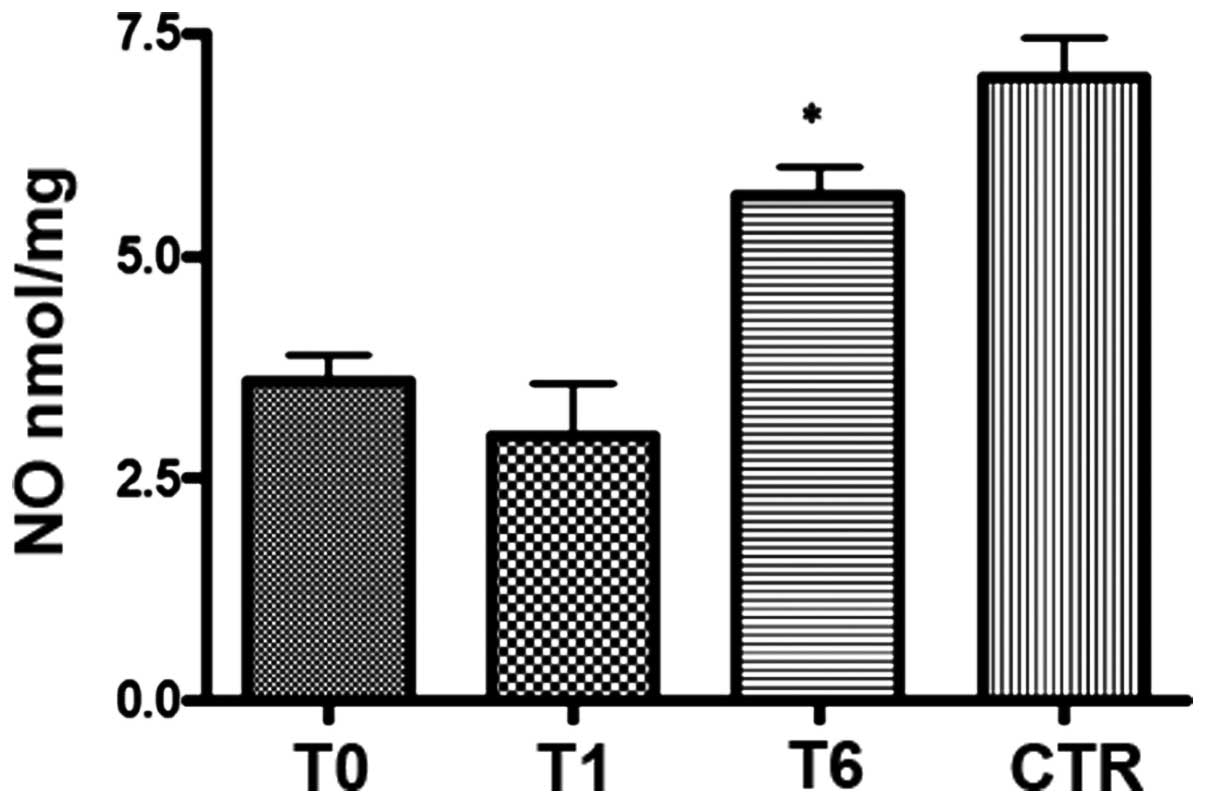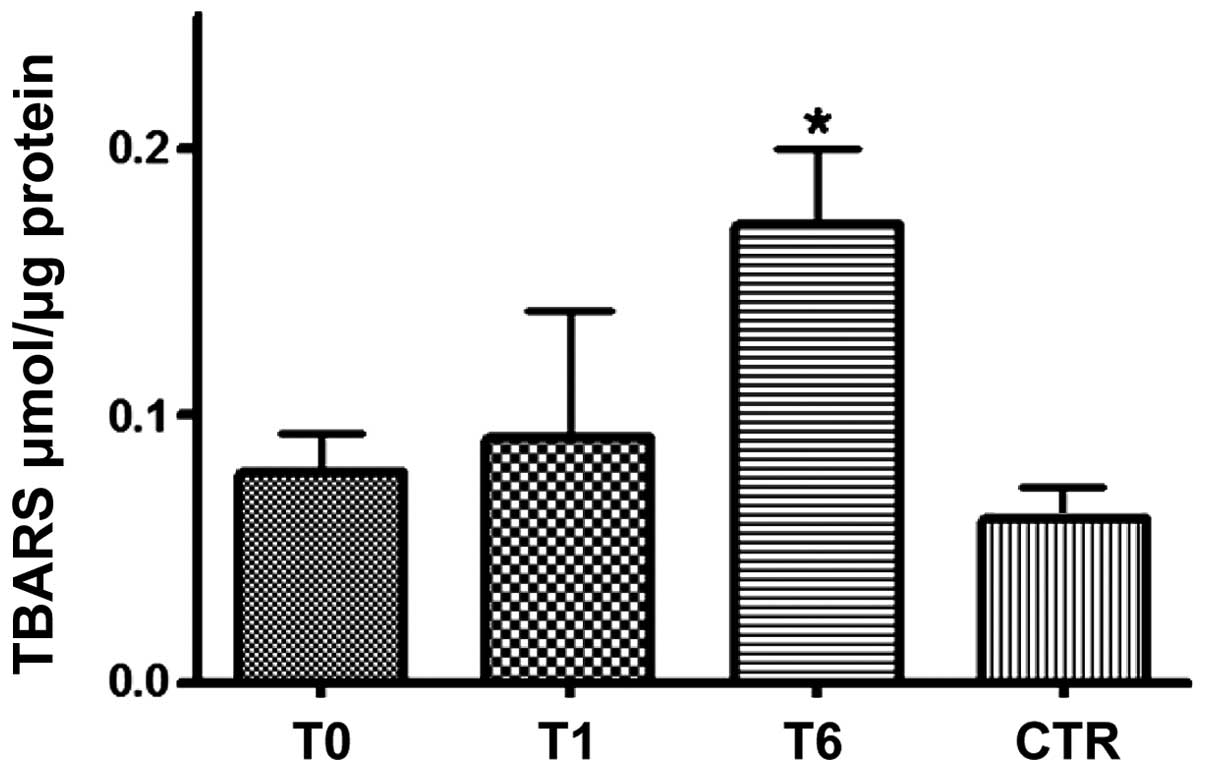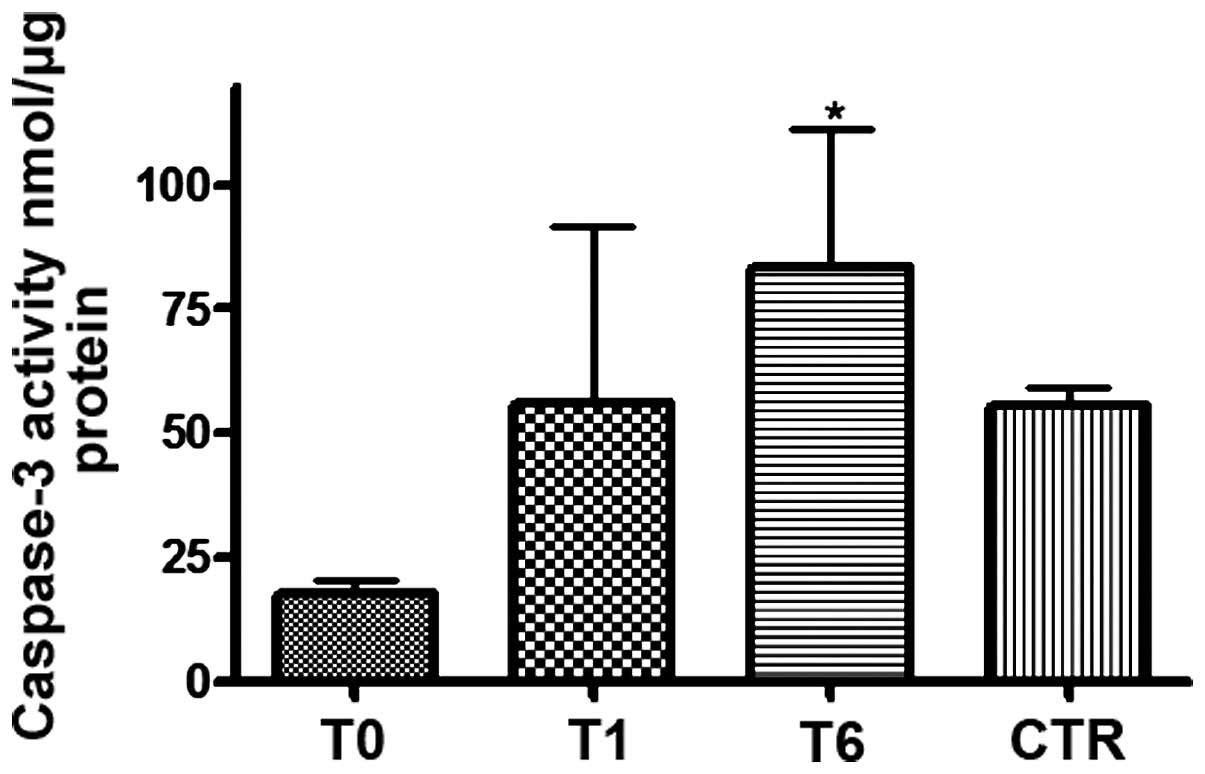|
1
|
McEnery MW, Snowman AM, Trifiletti RR and
Snyder SH: Isolation of the mitochondrial benzodiazepine receptor:
association with the voltage-dependent anion channel and the
adenine nucleotide carrier. Proc Natl Acad Sci. 89:3170–3174. 1992.
View Article : Google Scholar : PubMed/NCBI
|
|
2
|
Casellas P, Galiegue S and Basile AS:
Peripheral benzodiazepine receptors and mitochondrial function.
Neurochem Int. 40:475–486. 2002. View Article : Google Scholar : PubMed/NCBI
|
|
3
|
Sutter AP, Maaser K, Höpfner M, et al:
Specific ligands of the peripheral benzodiazepine receptor induce
apoptosis and cell cycle arrest in human esophageal cancer cells.
Int J Cancer. 102:318–327. 2002. View Article : Google Scholar : PubMed/NCBI
|
|
4
|
Zisterer, Campiani G, Nacci V and Williams
DC: Pyrrolo-1,5-benzoxazepines induce apoptosis in HL-60, Jurkat,
and Hut-78 cells: a new class of apoptotic agents. J Pharmacol Exp
Ther. 293:48–59. 2000.PubMed/NCBI
|
|
5
|
Carayon P, Portier M, Dussossoy D, Bord A,
Petitprêtre G, Canat X, Le Fur G and Casellas P: Involvement of
peripheral benzodiazepine receptors in the protection of
hematopoietic cells against oxygen radical damage. Blood.
87:3170–3178. 1996.PubMed/NCBI
|
|
6
|
Austin CJ, Kahlert J, Kassiou M and
Rendina LM: The translocator protein (TSPO): a novel target for
cancer chemotherapy. Int J Biochem Cell Biol. 45:1212–1216. 2013.
View Article : Google Scholar : PubMed/NCBI
|
|
7
|
Katz Y, Eitan A and Gavish M: Increase in
peripheral benzodiazepine binding sites in colonic adenocarcinoma.
Oncology. 47:139–142. 1990. View Article : Google Scholar : PubMed/NCBI
|
|
8
|
Cornu P, Benavides J, Scatton B, Hauw JJ
and Philippon J: Increase in omega 3 (peripheral-type
benzodiazepine) binding site densities in different types of human
brain tumours. A quantitative autoradiography study. Acta Neurochir
(Wien). 119:146–152. 1992. View Article : Google Scholar
|
|
9
|
Hardwick M, Fertikh D, Culty M, Li H,
Vidic B and Papadopoulos V: Peripheral-type benzodiazepine receptor
(PBR) in human breast cancer: correlation of breast cancer cell
aggressive phenotype with PBR expression, nuclear localization, and
PBR-mediated cell proliferation and nuclear transport of
cholesterol. Cancer Res. 59:831–842. 1999.PubMed/NCBI
|
|
10
|
Katz Y, Ben-Baruch G, Kloog Y, Menczer J
and Gavish M: Increased density of peripheral
benzodiazepine-binding sites in ovarian carcinomas as compared with
benign ovarian tumours and normal ovaries. Clin Sci (Lond).
78:155–158. 1990.
|
|
11
|
Batra S and Iosif CS: Elevated
concentrations of mitochondrial peripheral benzodiazepine receptors
in ovarian tumors. Int J Oncol. 12:1295–1298. 1998.PubMed/NCBI
|
|
12
|
Venturini I, Alho H, Podkletnova I, Corsi
L, Rybnikova E, Pellicci R, Baraldi M, Pelto-Huikko M, Helén P and
Zeneroli ML: Increased expression of peripheral benzodiazepine
receptors and diazepam binding inhibitor in human tumors sited in
the liver. Life Sci. 65:2223–2231. 1999. View Article : Google Scholar : PubMed/NCBI
|
|
13
|
Papadopoulos V: Peripheral-type
benzodiazepine/diazepam binding inhibitor receptor: biological role
in steroidogenic cell function. Endocr Rev. 14:222–240.
1993.PubMed/NCBI
|
|
14
|
Wu X and Gallo KA: The 18-kDa translocator
protein (TSPO) disrupts mammary epithelial morphogenesis and
promotes breast cancer cell migration. PLoS One. 8:e712582013.
View Article : Google Scholar : PubMed/NCBI
|
|
15
|
Beinlich A, Strohmeier R, Kaufmann M and
Kuhl H: Relation of cell proliferation to expression of peripheral
benzodiazepine receptors in human breast cancer cell lines. Biochem
Pharmacol. 60:397–402. 2000. View Article : Google Scholar : PubMed/NCBI
|
|
16
|
Landau M, Weizman A, Zoref-Shani E, Beery
E, Wasseman L, Landau O, Gavish M, Brenner S and Nordenberg J:
Antiproliferative and differentiating effects of benzodiazepine
receptor ligands on B16 melanoma cells. Biochem Pharmacol.
56:1029–1034. 1998. View Article : Google Scholar : PubMed/NCBI
|
|
17
|
Ikezaki K and Black KL: Stimulation of
cell growth and DNA synthesis by peripheral benzodiazepine. Cancer
Lett. 49:115–120. 1990. View Article : Google Scholar : PubMed/NCBI
|
|
18
|
Maaser K, Höpfner M, Jansen A, et al:
Specific ligands of the peripheral benzodiazepine receptor induce
apoptosis and cell cycle arrest in human colorectal cancer cells.
Br J Cancer. 85:1771–1780. 2001. View Article : Google Scholar : PubMed/NCBI
|
|
19
|
Alexander BE, Roller E and Klotz U:
Characterization of peripheral-type benzodiazepine binding sites on
human lymphocytes and lymphoma cell lines and their role in cell
growth. Biochem Pharmacol. 44:269–274. 1992. View Article : Google Scholar : PubMed/NCBI
|
|
20
|
Canat X, Carayon P, Bouaboula M, Cahard D,
Shire D, Roque C, Le Fur G and Casellas P: Distribution profile and
properties of peripheral-type benzodiazepine receptors on human
hemopoietic cells. Life Sci. 52:107–118. 1993. View Article : Google Scholar : PubMed/NCBI
|
|
21
|
O’Brien ER, Kersemans V, Tredwell M, Checa
B, Serres S, Soto MS, Gouverneur V, Leppert D, Anthony DC and
Sibson NR: Glial activation in the early stages of brain
metastasis: TSPO as a diagnostic biomarker. J Nucl Med. 55:275–280.
2014. View Article : Google Scholar
|
|
22
|
Beinlich A, Strohmeier R, Kaufmann M and
Kuhl H: Specific binding of benzodiazepines to human breast cancer
cell lines. Life Sci. 65:2099–2108. 1999. View Article : Google Scholar : PubMed/NCBI
|
|
23
|
Hardwick M, Fertikh D, Culty M, Li H,
Vidic B and Papadopoulos V: Peripheral-type benzodiazepine receptor
(PBR) in human breast cancer: correlation of breast cancer cell
aggressive phenotype with PBR expression, nuclear localization, and
PBR-mediated cell proliferation and nuclear transport of
cholesterol. Cancer Res. 59:831–842. 1999.PubMed/NCBI
|
|
24
|
Chiorazzi N, Rai KR and Ferrarini M:
Chronic lymphocytic leukemia. N Engl J Med. 352:804–815. 2005.
View Article : Google Scholar : PubMed/NCBI
|
|
25
|
Cheson BD, Bennett JM, Grever M, Kay N,
Keating MJ, O’Brien S and Rai KR: National Cancer
Institute-sponsored Working Group guidelines for chronic
lymphocytic leukemia: revised guidelines for diagnosis and
treatment. Blood. 87:4990–4997. 1996.PubMed/NCBI
|
|
26
|
Correale P, Campoccia G, Tsang KY, et al:
Recruitment of dendritic cells and enhanced antigen specific
immune-reactivity in cancer patients treated with hr-GM-CSF
(Molgramostim) and hr-IL-2: results from a phase Ib clinical trial.
Eur J Cancer. 37:892–902. 2001. View Article : Google Scholar : PubMed/NCBI
|
|
27
|
Gomez-Monterrey I, Campiglia P,
Scognamiglio I, Vanacore D, Dicitore A, Lombardi A, Caraglia M,
Novellino E and Stiuso P: DTNQ-Pro, a mimetic dipeptide, sensitizes
human colon cancer cells to 5-fluorouracil treatment. J Amino
Acids. 2013:5090562013. View Article : Google Scholar : PubMed/NCBI
|
|
28
|
Tenore GC, Manfra M, Stiuso P, Coppola L,
Russo M, Ritieni A and Campiglia P: Polyphenolic pattern and in
vitro cardioprotective properties of typical red wines from
vineyards cultivated in Scafati (Salerno, Italy). Food Chem.
140:803–809. 2013. View Article : Google Scholar : PubMed/NCBI
|
|
29
|
Veenman L and Gavish M: The role of 18 kDa
mitochondrial translocator protein (TSPO) in programmed cell death,
and effects of steroids on TSPO expression. Curr Mol Med.
12:398–412. 2012.PubMed/NCBI
|
|
30
|
Veenman L, Papadopoulos V and Gavish M:
Channel-like functions of the 18-kDa translocator protein (TSPO):
regulation of apoptosis and steroidogenesis as part of the
host-defense response. Curr Pharm Des. 13:2385–2405. 2007.
View Article : Google Scholar : PubMed/NCBI
|
|
31
|
Parker MA, Bazan HE, Marcheselli V,
Rodriguez de Turco EB and Bazan NG: Platelet-activating factor
induces permeability transition and cytochrome c release in
isolated brain mitochondria. J Neurosci Res. 69:39–50. 2002.
View Article : Google Scholar : PubMed/NCBI
|
|
32
|
Papadopoulos V, Baraldi M, Guilarte TR, et
al: Translocator protein (18 kDa): new nomenclature for the
peripheral-type benzodiazepine receptor based on its structure and
molecular function. Trends Pharmacol Sci. 27:402–409. 2006.
View Article : Google Scholar : PubMed/NCBI
|
|
33
|
Stoebner P E, Carayon P, Casellas P,
Portier M, Lavabre-Bertrand T, Cuq P, Cano JP, Meynadier J and
Meunier L: Transient protection by peripheral benzodiazepine
receptors during the early events of ultraviolet light-induced
apoptosis. Cell Death Differ. 8:747–753. 2001. View Article : Google Scholar : PubMed/NCBI
|
|
34
|
Hardwick M, Rone J, Han Z, Haddad B and
Papadopoulos V: Peripheral-type benzodiazepine receptor levels
correlate with the ability of human breast cancer MDA-MB-231 cell
line to grow in SCID mice. Int J Cancer. 94:322–327. 2001.
View Article : Google Scholar : PubMed/NCBI
|
|
35
|
Ridnour LA, Thomas DD, Switzer C, et al:
Molecular mechanisms for discrete nitric oxide levels in cancer.
Nitric Oxide. 19:73–76. 2008. View Article : Google Scholar : PubMed/NCBI
|
|
36
|
Prueitt RL, Boersma BJ, Howe TM, et al:
Inflammation and IGF-I activate the Akt pathway in breast cancer.
Int J Cancer. 120:796–805. 2007. View Article : Google Scholar
|


















